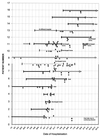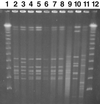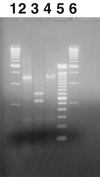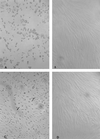Characterization of a toxin A-negative, toxin B-positive strain of Clostridium difficile responsible for a nosocomial outbreak of Clostridium difficile-associated diarrhea
- PMID: 10878068
- PMCID: PMC87004
- DOI: 10.1128/JCM.38.7.2706-2714.2000
Characterization of a toxin A-negative, toxin B-positive strain of Clostridium difficile responsible for a nosocomial outbreak of Clostridium difficile-associated diarrhea
Abstract
Clostridium difficile-associated diarrhea (CAD) is a very common nosocomial infection that contributes significantly to patient morbidity and mortality as well as to the cost of hospitalization. Previously, strains of toxin A-negative, toxin B-positive C. difficile were not thought to be associated with clinically significant disease. This study reports the characterization of a toxin A-negative, toxin B-positive strain of C. difficile that was responsible for a recently described nosocomial outbreak of CAD. Analysis of the seven patient isolates from the outbreak by pulsed-field gel electrophoresis indicated that this outbreak was due to transmission of a single strain of C. difficile. Our characterization of this strain (HSC98) has demonstrated that the toxin A gene lacks 1.8 kb from the carboxy repetitive oligopeptide (CROP) region but apparently has no other major deletions from other regions of the toxin A or toxin B gene. The remaining 1.3-kb fragment of the toxin A CROP region from strain HSC98 showed 98% sequence homology with strain 1470, previously reported by M. Weidmann in 1997 (GenBank accession number Y12616), suggesting that HSC98 is toxinotype VIII. The HSC98 strain infecting patients involved in this outbreak produced the full spectrum of clinical illness usually associated with C. difficile-associated disease. This pathogenic spectrum was manifest despite the inability of this strain to alter tight junctions as determined by using in vitro tissue culture testing, which suggested that no functional toxin A was produced by this strain.
Figures

 ), ward 2 (
), ward 2 ( ), and ward 4 (
), and ward 4 ( ) were general medical wards, and ward 3 (
) were general medical wards, and ward 3 ( ) was an oncology ward. The EIA tests used detected toxin A alone (a solid circle represents a positive test and an open circle represents a negative test) or toxin A and toxin B (a solid diamond represents a positive test and an open diamond represents a negative test). The cytotoxin test using HFF-cell culture was also performed (a solid square represents a positive test and an open square represents a negative test).
) was an oncology ward. The EIA tests used detected toxin A alone (a solid circle represents a positive test and an open circle represents a negative test) or toxin A and toxin B (a solid diamond represents a positive test and an open diamond represents a negative test). The cytotoxin test using HFF-cell culture was also performed (a solid square represents a positive test and an open square represents a negative test).



References
-
- Al-Barrak A, Embil J, Dyck B, Olekson K, Nicoll D, Alfa M, Kabani A. An outbreak of Toxin A negative, Toxin B positive Clostridium difficile-associated diarrhea in a Canadian tertiary-care hospital. Canada Communicable Dis Rep. 1999;25-7:1–3. - PubMed
-
- Altaie S S, Penque P H, Mookherjee S, Evans D T. Should laboratories test for Toxin A-negative, toxin B-positive Clostridium difficile? Lab Med. 1996;27:468–471.
-
- Bartlett J G. Clostridium difficile: clinical considerations. Rev Infect Dis. 1990;12(Suppl. 2):S243–S251. - PubMed
Publication types
MeSH terms
Substances
LinkOut - more resources
Full Text Sources
Other Literature Sources
Medical
Molecular Biology Databases
Miscellaneous

